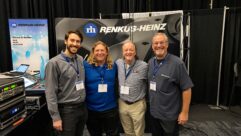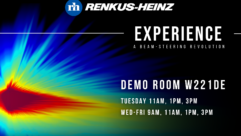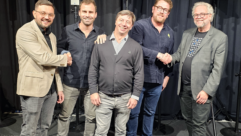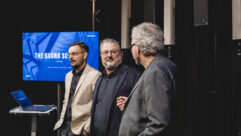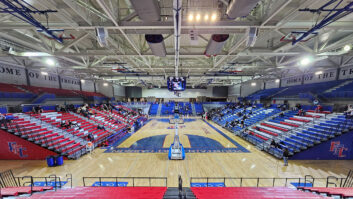
Toronto, ON, Canada—September 2017…A collaborative effort that combines the efforts of Ryerson University’s Faculties of Communication Arts and Design, Community Services and Engineering, the Responsive Ecologies Lab (RE/Lab) explores a wide variety of issues involving sensory technologies and tangible interactions. Run by Professors Jason Nolan (Director) and Canada Research Chair in Digital Media & Innovation Ali Mazalek, its many areas of exploration include the development of novel tools and interfaces to ensure that technologies become a more meaningful and usefully integrated part of our lives. For example, it seeks solutions for people with sensory integration disorders, such as autism, and enables research in data visualization and biomedicine.

Multitalented audio engineer Kenneth Emig’s ongoing challenge is to design and implement RE/Lab’s equipment infrastructure to support the audio aspects of this research. Emig’s background is almost as transdisciplinary as the lab, including working with live sound, designing and measuring the implementation of loudspeakers and microphones for hands-free telephones at Nortel, serving as Blackberry’s interface between design and manufacturing for audio issues, and a wide range of consulting work. His extensive experience designing and working in research labs prepared him well to meet the unique challenges at RE/Lab. He’s also an accomplished creative artist, and unsurprisingly, his art is transdisciplinary, integrating public artworks, installations, sound sculpture, dance, and technology into his practice.
For RE/Lab, Emig specified two different types of audio systems, one employing near field monitors for close-up work and another based on six Renkus-Heinz CF61-2 powered, two-way, Complex Conic point-source loudspeakers. “This way we have different listening conditions, depending on what’s needed,” Emig elaborates. “The near fields provide clarity and imaging close up. For the equivalent of a multichannel sound-reinforcement system, we have the Renkus-Heinz loudspeakers. This offers a diversity of tools. The director keeps calling me ‘Mr. Right Tool for the Job.’ Whatever the researchers want to do, I try to anticipate that and make sure they have the best equipment to accomplish it.”
Emig is quick to note that he doesn’t necessarily create systems at RE/Lab; rather, he creates an infrastructure of equipment to create opportunities for exploration. “We’re designing a laboratory that is as flexible as possible and can grow into the future. Researchers know where they want to start but they don’t really know where they will end up; most likely, they end up somewhere they don’t expect. I want to give them a diverse toolkit to best explore sound, refine their understanding, and then we’ll refine the required tools in the future when they understand more.”

RE/Lab didn’t have a really large budget, so Emig reserved a lot of the money for loudspeakers “so they can hear clearly, because that’s what’s most important,” he asserts. The Renkus-Heinz CF61-2s offered several advantages. “I want to give them tools they can grow into as they develop their work in the future,” Emig adds. “CF61-2s are pretty bombproof, and you can change their directionality by rotating the horn 90 degrees. They can deliver the kick that’s needed for some experiments. And I like them; they sound great.” Renkus-Heinz’ Complex Conic design delivers 150° by 60° dispersion with constant beamwidth and directivity, so rotating the horn provides the considerable variability Emig sought for his client.
The lab’s ceiling offers a flown grid constructed of Unistrut, enabling the CF61s to be located wherever needed. “You can build anything you want out of Unistrut, hang it from the ceiling, and place anything anywhere,” Emig observes. “We bought six Renkus-Heinz CF61 loudspeakers to create a far-field sound reinforcement environment that can get the lab in a lot of trouble if they turn it up. The CF61s has enough power to do whatever they need to do—more than enough.”
A stage box mounted in the ceiling enables multichannel recording and playback. “If you have six channels, you can configure all six CF61-2s in a circle, you can configure them in an array, you can change the directivity—you can do whatever you want,” details Emig. “Right now I have four CF61-2s mounted above a wall of 12 55-inch MultiTaction touchscreen displays, which I designed the mounting for and installed last year. The design is always being refined—it’s a living, ever-evolving space. It can be complicated, especially in a room with a reflective raised floor and an open ceiling, as well as equipment and tables moving around the lab all the time. I’ve started to mitigate some of the issues but this is a work in progress, combining technical knowledge with awareness and understanding.”

Having spent much of his audio budget on top-quality speakers, Emig filled in the rest of his core gear. “I specified some okay microphones for a diversity of tasks,” he states. “I spec’d a Behringer X32 digital console, and I’ve snaked around their Ethernet stage boxes so the researchers can run it from wherever they want. They can control it from a tablet or a laptop, so they can be in the middle of another space in the lab and control what they want to hear. So as with the Renkus-Heinz loudspeakers, it comes back to creating diversity of opportunity.
With his decades of experience in lab design and operation, Emig is deeply aware that his designs directly impact how research is done at RE/Lab. “When you design a laboratory, you greatly influence what the researchers do,” he explains. “The equipment you provide allows the researchers to go in certain directions. They bring you in because this is your area of expertise. I specified all the sound equipment for the lab, with the researchers’ approval, to allow them to best explore sound the way they wanted to. Our movable Renkus-Heinz CF61-2 loudspeaker configuration gives the team at RE/Lab the flexibility, power, and outstanding clarity they need to explore sound as part of the plethora of sensory inputs that we humans have.”


